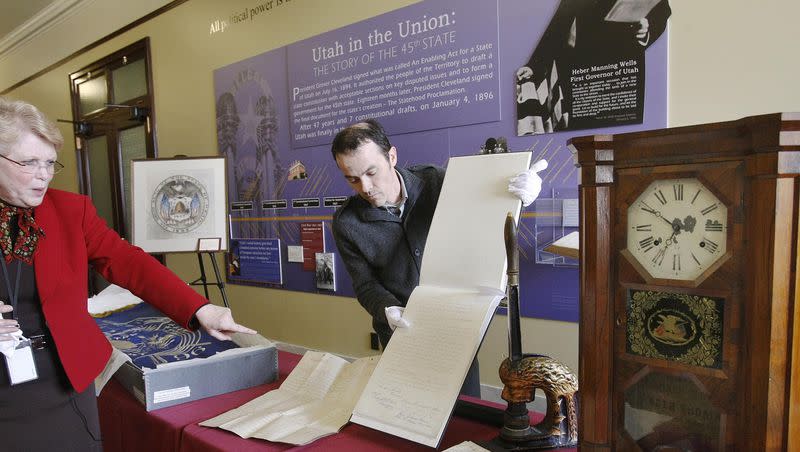Opinion: Celebrating all of America’s constitutions

- Oops!Something went wrong.Please try again later.
When we talk of our constitutional tradition in the United States, we speak of the Constitution, a single document, a single founding act of We the People. At one level, that’s true: The U.S. Constitution is a durable frame of government. It has remained remarkably stable for more than two centuries, weathering political disunion, economic depression, worldwide conflict and now culture war.
Though we have amended the Constitution 27 times, none of those amendments have altered the basic structure of the government. They have tended instead to clarify the definition of citizenship and extend protections of the Constitution to more and more people.
The static character of the federal Constitution may be good or bad, depending on how you look at it. To some, it represents a dead hand of the past, a stale rather than stable Constitution. It is not We the People binding the federal government to our sovereign will, but a long-gone generation binding the living.
Thomas Jefferson first advanced this criticism in 1789 as he was preparing to return from France and assume office as the nation’s first secretary of state. James Madison, to whom Jefferson was writing at the time, responded with the observation that good constitutions are fragile and hard to come by, “form(ing) a debt against the living.” Those who inherit a good constitution therefore have an obligation to preserve as well as improve it.
Rather than prosecuting that old dispute, let’s look past it for a moment. The American constitutional tradition is not in fact as stable and static as the federal Constitution makes it appear. Americans have not had just one constitution; they have had more than 200 constitutions — at the state level. The American constitutional tradition is one of constant founding and re-founding of state governments.
This malleability — critics would say mutability — of state constitutions may at first glance seem insignificant alongside the perpetuity of the federal Constitution. After all, we simply don’t pay as much attention to our state constitutions as we do our national Constitution. But that neglect grossly underestimates the actual effect of state constitutions on the prosperity and political liberty of the American people.
State constitutions, in reality, are more deeply threaded into the fabric of daily life for most of us than the federal Constitution. To take but one example, access to education, a critical issue on which the U.S. Constitution has relatively little to say, is routinely secured and regulated in state constitutions. Moreover, as federal protections for property rights, religious liberty and equal-opportunity employment have receded or slowed in recent years, state constitutions have increasingly picked up the slack.
State constitutions are also more accessible in the sense that ordinary people have greater capacity to bring about changes in them. This is important because the argument that an enduring Constitution represents the will of the dead ruling a living generation is commonly refuted by pointing to the capacity of today’s citizens to improve or replace it.
Related
‘To support and defend’: A veteran’s view on the Constitution
Gov. Cox kicks off American Founders and Constitution Month in Utah
From this perspective, it’s not the original act of ratification that gives a constitution its fundamental democratic authority, but the ongoing ability of the people to amend it. It is the Article 5 amendment process just as much as the Article 7 ratification process that puts teeth into the federal Constitution’s claim in its preamble to be an act of We the People.
The federal Constitution’s republican credentials were defended on this very ground during the ratification debates in 1787 and 1788. Its critics, including Jefferson, have since questioned whether it is too difficult to amend. But no one can make a serious case against state constitutions on those grounds. New state constitutions are not only more frequently made, they are more easily amended. It took two centuries to pass 27 amendments to the federal Constitution. The people of Utah have amended their constitution 24 times since 2016.
Recent Supreme Court decisions have moved state constitutions and the process for amending them into the spotlight. By rolling back the judicially created right to privacy in its recent abortion decisions, the Supreme Court has largely dismantled the national uniformity that prevailed for the last half-century. Instead, those seeking to preserve abortion rights from state intrusion, as well as those looking to protect the unborn, must now look to state constitutions to do so. The resulting struggle has revived Americans’ interest in their state constitutions. The comparative ease with which many state constitutions can be amended is suddenly a matter of urgent concern and will become more so as the 2024 election approaches.
Because state constitutions are closer to the people, more entwined into their daily lives — and more amenable to change — it is critically important that people appreciate their state constitutions as part of the American constitutional tradition. This is something to remember this September, which in Utah is Founders and Constitution month. Sept. 17, the date on which delegates to the Constitutional Convention in 1787 signed the completed document, is set aside in federal law as Constitution Day.
Institutions of higher education, schools, local governments, citizen groups and other organizations around the state will give Utahns occasion to celebrate and learn about the Framers’ accomplishment. Perhaps uniquely, the Center for Constitutional Studies at UVU will mark the occasion at the end of this week with a Constitution Day conference celebrating America’s rich, ongoing state-constitutional tradition, reminding us that constitutional self-government is not just an episode in American history but an ongoing civic duty.
Matthew Brogdon serves as senior director of the Center for Constitutional Studies at Utah Valley University.

